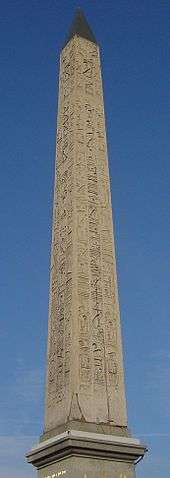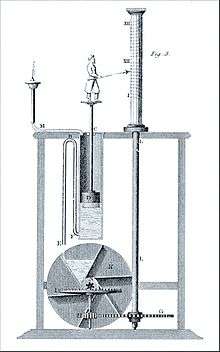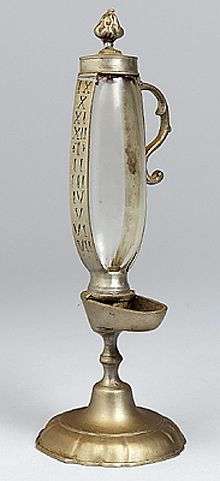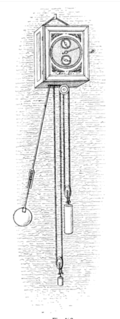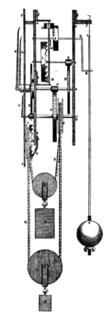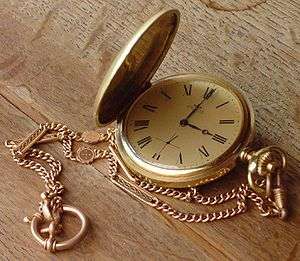History of timekeeping devices

For thousands of years, devices have been used to measure and keep track of time. The current sexagesimal system of time measurement dates to approximately 2000 BCE from the Sumerians.
The Ancient Egyptians divided the day into two 12-hour periods, and used large obelisks to track the movement of the sun. They also developed water clocks, which were probably first used in the Precinct of Amun-Re, and later outside Egypt as well; they were employed frequently by the Ancient Greeks, who called them clepsydrae. The Zhou dynasty is believed to have used the outflow water clock around the same time, devices which were introduced from Mesopotamia as early as 2000 BCE.
Other ancient timekeeping devices include the candle clock, used in ancient China, ancient Japan, England and Mesopotamia; the timestick, widely used in India and Tibet, as well as some parts of Europe; and the hourglass, which functioned similarly to a water clock. The sundial, another early clock, relies on shadows to provide a good estimate of the hour on a sunny day. It is not so useful in cloudy weather or at night and requires recalibration as the seasons change (if the gnomon was not aligned with the Earth's axis).
The earliest known clock with a water-powered escapement mechanism, which transferred rotational energy into intermittent motions,[1] dates back to 3rd century BCE in ancient Greece;[2] Chinese engineers later invented clocks incorporating mercury-powered escapement mechanisms in the 10th century,[3] followed by Iranian engineers inventing water clocks driven by gears and weights in the 11th century.[4]
The first mechanical clocks, employing the verge escapement mechanism with a foliot or balance wheel timekeeper, were invented in Europe at around the start of the 14th century, and became the standard timekeeping device until the pendulum clock was invented in 1656. The invention of the mainspring in the early 15th century allowed portable clocks to be built, evolving into the first pocketwatches by the 17th century, but these were not very accurate until the balance spring was added to the balance wheel in the mid 17th century.
The pendulum clock remained the most accurate timekeeper until the 1930s, when quartz oscillators were invented, followed by atomic clocks after World War 2. Although initially limited to laboratories, the development of microelectronics in the 1960s made quartz clocks both compact and cheap to produce, and by the 1980s they became the world's dominant timekeeping technology in both clocks and wristwatches.
Atomic clocks are far more accurate than any previous timekeeping device, and are used to calibrate other clocks and to calculate the International Atomic Time; a standardized civil system, Coordinated Universal Time, is based on atomic time.
Timekeeping devices of early civilizations
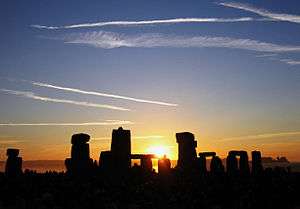
Many ancient civilizations observed astronomical bodies, often the Sun and Moon, to determine times, dates, and seasons.[5][6] Methods of sexagesimal timekeeping, now common in both Western and Eastern societies, originated nearly 4,000 years ago in Mesopotamia and Egypt;[5][7] a similar system was developed later in Mesoamerica.[8] The first calendars may have been created during the last glacial period, by hunter-gatherers who employed tools such as sticks and bones to track the phases of the moon or the seasons.[6] Stone circles, such as England's Stonehenge, were built in various parts of the world, especially in Prehistoric Europe, and are thought to have been used to time and predict seasonal and annual events such as equinoxes or solstices.[6][9] As those megalithic civilizations left no recorded history, little is known of their calendars or timekeeping methods.[10]
Ancient Egypt
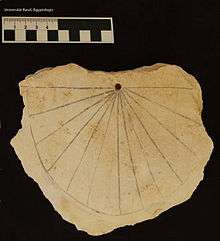
The oldest known sundial is from Egypt; it dates back to around 1500 BCE (19th Dynasty), and was discovered in the Valley of the Kings in 2013.[11] Sundials have their origin in shadow clocks, which were the first devices used for measuring the parts of a day.[12] Ancient Egyptian obelisks, constructed about 3500 BCE, are also among the earliest shadow clocks.[6][13][14]
Egyptian shadow clocks divided daytime into 12 parts with each part further divided into more precise parts.[11] One type of shadow clock consisted of a long stem with five variable marks and an elevated crossbar which cast a shadow over those marks. It was positioned eastward in the morning, and was turned west at noon. Obelisks functioned in much the same manner: the shadow cast on the markers around it allowed the Egyptians to calculate the time. The obelisk also indicated whether it was morning or afternoon, as well as the summer and winter solstices.[6][15] A third shadow clock, developed c. 1500 BCE, was similar in shape to a bent T-square. It measured the passage of time by the shadow cast by its crossbar on a non-linear rule. The T was oriented eastward in the mornings, and turned around at noon, so that it could cast its shadow in the opposite direction.[16]
Although accurate, shadow clocks relied on the sun, and so were useless at night and in cloudy weather.[15][17] The Egyptians therefore developed a number of alternative timekeeping instruments, including water clocks, and a system for tracking star movements. The oldest description of a water clock is from the tomb inscription of the 16th-century BCE Egyptian court official Amenemhet, identifying him as its inventor.[18] There were several types of water clocks, some more elaborate than others. One type consisted of a bowl with small holes in its bottom, which was floated on water and allowed to fill at a near-constant rate; markings on the side of the bowl indicated elapsed time, as the surface of the water reached them. The oldest-known waterclock was found in the tomb of pharaoh Amenhotep I (1525–1504 BCE), suggesting that they were first used in ancient Egypt.[15][19][20] Another Egyptian method of determining the time during the night was using plumb-lines called merkhets. In use since at least 600 BCE, two of these instruments were aligned with Polaris, the north pole star, to create a north–south meridian. The time was accurately measured by observing certain stars as they crossed the line created with the merkhets.[15][21]
Ancient Greece and Rome
Water clocks, or clepsydrae, were commonly used in Ancient Greece following their introduction by Plato, who also invented a water-based alarm clock.[23][24] One account of Plato's alarm clock describes it as depending on the nightly overflow of a vessel containing lead balls, which floated in a columnar vat. The vat held a steadily increasing amount of water, supplied by a cistern. By morning, the vessel would have floated high enough to tip over, causing the lead balls to cascade onto a copper platter. The resultant clangor would then awaken Plato's students at the Academy.[25] Another possibility is that it comprised two jars, connected by a siphon. Water emptied until it reached the siphon, which transported the water to the other jar. There, the rising water would force air through a whistle, sounding an alarm.[24] The Greeks and Chaldeans regularly maintained timekeeping records as an essential part of their astronomical observations.
Greek astronomer, Andronicus of Cyrrhus, supervised the construction of the Tower of the Winds in Athens in the 1st century BCE.
In Greek tradition, clepsydrae were used in court; later, the Romans adopted this practice, as well. There are several mentions of this in historical records and literature of the era; for example, in Theaetetus, Plato says that "Those men, on the other hand, always speak in haste, for the flowing water urges them on".[26] Another mention occurs in Lucius Apuleius' The Golden Ass: "The Clerk of the Court began bawling again, this time summoning the chief witness for the prosecution to appear. Up stepped an old man, whom I did not know. He was invited to speak for as long as there was water in the clock; this was a hollow globe into which water was poured through a funnel in the neck, and from which it gradually escaped through fine perforations at the base".[27] The clock in Apuleius's account was one of several types of water clock used. Another consisted of a bowl with a hole in its centre, which was floated on water. Time was kept by observing how long the bowl took to fill with water.[28]
Although clepsydrae were more useful than sundials—they could be used indoors, during the night, and also when the sky was cloudy—they were not as accurate; the Greeks, therefore, sought a way to improve their water clocks.[29] Although still not as accurate as sundials, Greek water clocks became more accurate around 325 BCE, and they were adapted to have a face with an hour hand, making the reading of the clock more precise and convenient. One of the more common problems in most types of clepsydrae was caused by water pressure: when the container holding the water was full, the increased pressure caused the water to flow more rapidly. This problem was addressed by Greek and Roman horologists beginning in 100 BCE, and improvements continued to be made in the following centuries. To counteract the increased water flow, the clock's water containers—usually bowls or jugs—were given a conical shape; positioned with the wide end up, a greater amount of water had to flow out in order to drop the same distance as when the water was lower in the cone. Along with this improvement, clocks were constructed more elegantly in this period, with hours marked by gongs, doors opening to miniature figurines, bells, or moving mechanisms.[15] There were some remaining problems, however, which were never solved, such as the effect of temperature. Water flows more slowly when cold, or may even freeze.[30]
Between 270 BCE and 500 CE, Hellenistic (Ctesibius, Hero of Alexandria, Archimedes) and Roman horologists and astronomers began developing more elaborate mechanized water clocks. The added complexity was aimed at regulating the flow and at providing fancier displays of the passage of time. For example, some water clocks rang bells and gongs, while others opened doors and windows to show figurines of people, or moved pointers, and dials. Some even displayed astrological models of the universe.
Although the Greeks and Romans did much to advance water clock technology, they still continued to use shadow clocks. The mathematician and astronomer Theodosius of Bithynia, for example, is said to have invented a universal sundial that was accurate anywhere on Earth, though little is known about it.[31] Others wrote of the sundial in the mathematics and literature of the period. Marcus Vitruvius Pollio, the Roman author of De Architectura, wrote on the mathematics of gnomons, or sundial blades.[32] During the reign of Emperor Augustus, the Romans constructed the largest sundial ever built, the Solarium Augusti. Its gnomon was an obelisk from Heliopolis.[33] Similarly, the obelisk from Campus Martius was used as the gnomon for Augustus's zodiacal sundial.[34] Pliny the Elder records that the first sundial in Rome arrived in 264 BCE, looted from Catania, Sicily; according to him, it gave the incorrect time until the markings and angle appropriate for Rome's latitude were used—a century later.[35]
Persia
According to Callisthenes, the Persians were using water clocks in 328 BCE to ensure a just and exact distribution of water from qanats to their shareholders for agricultural irrigation. The use of water clocks in Iran, especially in Zeebad, dates back to 500BCE. Later they were also used to determine the exact holy days of pre-Islamic religions, such as the Nowruz, Chelah, or Yaldā – the shortest, longest, and equal-length days and nights of the years. The water clocks used in Iran were one of the most practical ancient tools for timing the yearly calendar.[36]
Water clocks, or Fenjaan, in Persia reached a level of accuracy comparable to today's standards of timekeeping. The fenjaan was the most accurate and commonly used timekeeping device for calculating the amount or the time that a farmer must take water from a qanat or well for irrigation of the farms, until it was replaced by more accurate current clock.[36] Persian water clocks were a practical and useful tool for the qanat's shareholders to calculate the length of time they could divert water to their farm. The qanat was the only water source for agriculture and irrigation so a just and fair water distribution was very important. Therefore, a very fair and clever old person was elected to be the manager of the water clock, and at least two full-time managers were needed to control and observe the number of fenjaans and announce the exact time during the days and nights.[37]
The fenjaan was a big pot full of water and a bowl with small hole in the center. When the bowl become full of water, it would sink into the pot, and the manager would empty the bowl and again put it on the top of the water in the pot. He would record the number of times the bowl sank by putting small stones into a jar.[37]
The place where the clock was situated, and its managers, were collectively known as khaneh fenjaan. Usually this would be the top floor of a public-house, with west- and east-facing windows to show the time of sunset and sunrise. There was also another time-keeping tool named a staryab or astrolabe, but it was mostly used for superstitious beliefs and was not practical for use as a farmers' calendar. The Zeebad Gonabad water clock was in used until 1965 when it was substituted by modern clocks.[36]
China
Joseph Needham speculated that the introduction of the outflow clepsydra to China, perhaps from Mesopotamia, occurred as far back as the 2nd millennium BCE, during the Shang Dynasty, and at the latest by the 1st millennium BCE. By the beginning of the Han Dynasty, in 202 BCE, the outflow clepsydra was gradually replaced by the inflow clepsydra, which featured an indicator rod on a float. To compensate for the falling pressure head in the reservoir, which slowed timekeeping as the vessel filled, Zhang Heng added an extra tank between the reservoir and the inflow vessel. Around 550 AD, Yin Gui was the first in China to write of the overflow or constant-level tank added to the series, which was later described in detail by the inventor Shen Kuo. Around 610, this design was trumped by two Sui Dynasty inventors, Geng Xun and Yuwen Kai, who were the first to create the balance clepsydra, with standard positions for the steelyard balance.[38] Joseph Needham states that:
... [the balance clepsydra] permitted the seasonal adjustment of the pressure head in the compensating tank by having standard positions for the counterweight graduated on the beam, and hence it could control the rate of flow for different lengths of day and night. With this arrangement no overflow tank was required, and the two attendants were warned when the clepsydra needed refilling.[38]
Clocks by type
The term 'clock' encompasses a wide spectrum of devices, ranging from wristwatches to the Clock of the Long Now. The English word clock is said to derive from the Middle English clokke, Old North French cloque, or Middle Dutch clocke, all of which mean bell, and are derived from the Medieval Latin clocca, also meaning bell.[39][40][41] Indeed, bells were used to mark the passage of time; they marked the passage of the hours at sea and in abbeys.
Throughout history, clocks have had a variety of power sources, including gravity, springs, and electricity.[42][43] Mechanical clocks became widespread in the 14th century, when they were used in medieval monasteries to keep the regulated schedule of prayers. The clock continued to be improved, with the first pendulum clock being designed and built in the 17th century.
Candle clocks
The earliest mention of candle clocks comes from a Chinese poem, written in 520 CE by You Jianfu. According to the poem, the graduated candle was a means of determining time at night. Similar candles were used in Japan until the early 10th century.[44]
The candle clock most commonly mentioned and written of is attributed to King Alfred the Great. It consisted of six candles made from 72 pennyweights of wax, each 12 inches (30 cm) high, and of uniform thickness, marked every inch (2.54 cm). As these candles burned for about four hours, each mark represented 20 minutes. Once lit, the candles were placed in wooden framed glass boxes, to prevent the flame from extinguishing.[45]
The most sophisticated candle clocks of their time were those of Al-Jazari in 1206. One of his candle clocks included a dial to display the time and, for the first time, employed a bayonet fitting, a fastening mechanism still used in modern times.[46] Donald Routledge Hill described Al-Jazari's candle clocks as follows:
The candle, whose rate of burning was known, bore against the underside of the cap, and its wick passed through the hole. Wax collected in the indentation and could be removed periodically so that it did not interfere with steady burning. The bottom of the candle rested in a shallow dish that had a ring on its side connected through pulleys to a counterweight. As the candle burned away, the weight pushed it upward at a constant speed. The automata were operated from the dish at the bottom of the candle. No other candle clocks of this sophistication are known.[47]
A variation on this theme were oil-lamp clocks. These early timekeeping devices consisted of a graduated glass reservoir to hold oil — usually whale oil, which burned cleanly and evenly — supplying the fuel for a built-in lamp. As the level in the reservoir dropped, it provided a rough measure of the passage of time.
Incense clocks
In addition to water, mechanical, and candle clocks, incense clocks were used in the Far East, and were fashioned in several different forms.[48] Incense clocks were first used in China around the 6th century; in Japan, one still exists in the Shōsōin,[49] although its characters are not Chinese, but Devanagari.[50] Due to their frequent use of Devanagari characters, suggestive of their use in Buddhist ceremonies, Edward H. Schafer speculated that incense clocks were invented in India.[50] Although similar to the candle clock, incense clocks burned evenly and without a flame; therefore, they were more accurate and safer for indoor use.[51]
Several types of incense clock have been found, the most common forms include the incense stick and incense seal.[52][53] An incense stick clock was an incense stick with calibrations;[53] most were elaborate, sometimes having threads, with weights attached, at even intervals. The weights would drop onto a platter or gong below, signifying that a certain amount of time had elapsed. Some incense clocks were held in elegant trays; open-bottomed trays were also used, to allow the weights to be used together with the decorative tray.[54][55] Sticks of incense with different scents were also used, so that the hours were marked by a change in fragrance.[56] The incense sticks could be straight or spiraled; the spiraled ones were longer, and were therefore intended for long periods of use, and often hung from the roofs of homes and temples.[57]
In Japan, a geisha was paid for the number of senkodokei (incense sticks) that had been consumed while she was present, a practice which continued until 1924.[58] Incense seal clocks were used for similar occasions and events as the stick clock; while religious purposes were of primary importance,[52] these clocks were also popular at social gatherings, and were used by Chinese scholars and intellectuals.[59] The seal was a wooden or stone disk with one or more grooves etched in it[52] into which incense was placed.[60] These clocks were common in China,[59] but were produced in fewer numbers in Japan.[61] To signal the passage of a specific amount of time, small pieces of fragrant woods, resins, or different scented incenses could be placed on the incense powder trails. Different powdered incense clocks used different formulations of incense, depending on how the clock was laid out.[62] The length of the trail of incense, directly related to the size of the seal, was the primary factor in determining how long the clock would last; all burned for long periods of time, ranging between 12 hours and a month.[63][64][65]
While early incense seals were made of wood or stone, the Chinese gradually introduced disks made of metal, most likely beginning during the Song dynasty. This allowed craftsmen to more easily create both large and small seals, as well as design and decorate them more aesthetically. Another advantage was the ability to vary the paths of the grooves, to allow for the changing length of the days in the year. As smaller seals became more readily available, the clocks grew in popularity among the Chinese, and were often given as gifts.[66] Incense seal clocks are often sought by modern-day clock collectors; however, few remain that have not already been purchased or been placed on display at museums or temples.[61]
Sundials
Sundials had been used for timekeeping since Ancient Egypt. Ancient dials were nodus-based with straight hour-lines that indicated unequal hours—also called temporary hours—that varied with the seasons. Every day was divided into 12 equal segments regardless of the time of year; thus, hours were shorter in winter and longer in summer. The sundial was further developed by Muslim astronomers. The idea of using hours of equal length throughout the year was the innovation of Abu'l-Hasan Ibn al-Shatir in 1371, based on earlier developments in trigonometry by Muhammad ibn Jābir al-Harrānī al-Battānī (Albategni). Ibn al-Shatir was aware that "using a gnomon that is parallel to the Earth's axis will produce sundials whose hour lines indicate equal hours on any day of the year". His sundial is the oldest polar-axis sundial still in existence. The concept appeared in Western sundials starting in 1446.[67][68]
Following the acceptance of heliocentrism and equal hours, as well as advances in trigonometry, sundials appeared in their present form during the Renaissance, when they were built in large numbers.[69] In 1524, the French astronomer Oronce Finé constructed an ivory sundial, which still exists;[70] later, in 1570, the Italian astronomer Giovanni Padovani published a treatise including instructions for the manufacture and laying out of mural (vertical) and horizontal sundials. Similarly, Giuseppe Biancani's Constructio instrumenti ad horologia solaria (c. 1620) discusses how to construct sundials.[71]
Clocks with gears and escapements
The earliest instance of a liquid-driven escapement was described by the Greek engineer Philo of Byzantium (fl. 3rd century BCE) in his technical treatise Pneumatics (chapter 31) where he likens the escapement mechanism of a washstand automaton with those as employed in (water) clocks.[2] Another early clock to use escapements was built during the 7th century in Chang'an, by Tantric monk and mathematician, Yi Xing, and government official Liang Lingzan.[72][73] An astronomical instrument that served as a clock, it was discussed in a contemporary text as follows:[74]
[It] was made in the image of the round heavens and on it were shown the lunar mansions in their order, the equator and the degrees of the heavenly circumference. Water, flowing into scoops, turned a wheel automatically, rotating it one complete revolution in one day and night. Besides this, there were two rings fitted around the celestial sphere outside, having the sun and moon threaded on them, and these were made to move in circling orbit ... And they made a wooden casing the surface of which represented the horizon, since the instrument was half sunk in it. It permitted the exact determinations of the time of dawns and dusks, full and new moons, tarrying and hurrying. Moreover, there were two wooden jacks standing on the horizon surface, having one a bell and the other a drum in front of it, the bell being struck automatically to indicate the hours, and the drum being beaten automatically to indicate the quarters. All these motions were brought about by machinery within the casing, each depending on wheels and shafts, hooks, pins and interlocking rods, stopping devices and locks checking mutually.[74]
Since Yi Xing's clock was a water clock, it was affected by temperature variations. That problem was solved in 976 by Zhang Sixun by replacing the water with mercury, which remains liquid down to −39 °C (−38 °F). Zhang implemented the changes into his clock tower, which was about 10 metres (33 ft) tall, with escapements to keep the clock turning and bells to signal every quarter-hour. Another noteworthy clock, the elaborate Cosmic Engine, was built by Su Song, in 1088. It was about the size of Zhang's tower, but had an automatically rotating armillary sphere—also called a celestial globe—from which the positions of the stars could be observed. It also featured five panels with mannequins ringing gongs or bells, and tablets showing the time of day, or other special times.[15] Furthermore, it featured the first known endless power-transmitting chain drive in horology.[3] Originally built in the capital of Kaifeng, it was dismantled by the Jin army and sent to the capital of Yanjing (now Beijing), where they were unable to put it back together. As a result, Su Song's son Su Xie was ordered to build a replica.[75]

The clock towers built by Zhang Sixun and Su Song, in the 10th and 11th centuries, respectively, also incorporated a striking clock mechanism, the use of clock jacks to sound the hours.[76] A striking clock outside of China was the Jayrun Water Clock, at the Umayyad Mosque in Damascus, Syria, which struck once every hour. It was constructed by Muhammad al-Sa'ati in the 12th century, and later described by his son Ridwan ibn al-Sa'ati, in his On the Construction of Clocks and their Use (1203), when repairing the clock.[77] In 1235, an early monumental water-powered alarm clock that "announced the appointed hours of prayer and the time both by day and by night" was completed in the entrance hall of the Mustansiriya Madrasah in Baghdad.[78]
The first geared clock was invented in the 11th century by the Arab engineer Ibn Khalaf al-Muradi in Islamic Iberia; it was a water clock that employed a complex gear train mechanism, including both segmental and epicyclic gearing,[4][79] capable of transmitting high torque. The clock was unrivalled in its use of sophisticated complex gearing, until the mechanical clocks of the mid-14th century.[79] Al-Muradi's clock also employed the use of mercury in its hydraulic linkages,[80][81] which could function mechanical automata.[81] Al-Muradi's work was known to scholars working under Alfonso X of Castile,[82] hence the mechanism may have played a role in the development of the European mechanical clocks.[79] Other monumental water clocks constructed by medieval Muslim engineers also employed complex gear trains and arrays of automata.[83] Like the earlier Greeks and Chinese, Arab engineers at the time also developed a liquid-driven escapement mechanism which they employed in some of their water clocks. Heavy floats were used as weights and a constant-head system was used as an escapement mechanism,[4] which was present in the hydraulic controls they used to make heavy floats descend at a slow and steady rate.[83]
A mercury clock, described in the Libros del saber de Astronomia, a Spanish work from 1277 consisting of translations and paraphrases of Arabic works, is sometimes quoted as evidence for Muslim knowledge of a mechanical clock. However, the device was actually a compartmented cylindrical water clock,[84] which the Jewish author of the relevant section, Rabbi Isaac, constructed using principles described by a philosopher named "Iran", identified with Heron of Alexandria (fl. 1st century AD), on how heavy objects may be lifted.[85]
Astronomical clocks
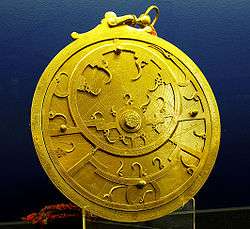
During the 11th century in the Song Dynasty, the Chinese astronomer, horologist and mechanical engineer Su Song created a water-driven astronomical clock for his clock tower of Kaifeng City. It incorporated an escapement mechanism as well as the earliest known endless power-transmitting chain drive, which drove the armillary sphere.
Contemporary Muslim astronomers also constructed a variety of highly accurate astronomical clocks for use in their mosques and observatories,[86] such as the water-powered astronomical clock by Al-Jazari in 1206,[87] and the astrolabic clock by Ibn al-Shatir in the early 14th century.[88] The most sophisticated timekeeping astrolabes were the geared astrolabe mechanisms designed by Abū Rayhān Bīrūnī in the 11th century and by Muhammad ibn Abi Bakr in the 13th century. These devices functioned as timekeeping devices and also as calendars.[4]
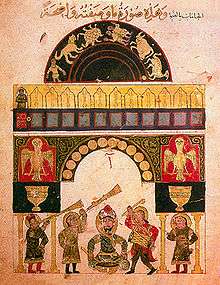
A sophisticated water-powered astronomical clock was built by Al-Jazari in 1206. This castle clock was a complex device that was about 11 feet (3.4 m) high, and had multiple functions alongside timekeeping. It included a display of the zodiac and the solar and lunar paths, and a pointer in the shape of the crescent moon which travelled across the top of a gateway, moved by a hidden cart and causing doors to open, each revealing a mannequin, every hour.[47][89] It was possible to reset the length of day and night in order to account for the changing lengths of day and night throughout the year. This clock also featured a number of automata including falcons and musicians who automatically played music when moved by levers operated by a hidden camshaft attached to a water wheel.[90]
Hourglass
Since the hourglass was one of the few reliable methods of measuring time at sea, it is speculated that it was used on board ships as far back as the 11th century, when it would have complemented the magnetic compass as an aid to navigation. However, the earliest unambiguous evidence of their use appears in the painting Allegory of Good Government, by Ambrogio Lorenzetti, from 1338.[91] From the 15th century onwards, hourglasses were used in a wide range of applications at sea, in churches, in industry, and in cooking; they were the first dependable, reusable, reasonably accurate, and easily constructed time-measurement devices. The hourglass also took on symbolic meanings, such as that of death, temperance, opportunity, and Father Time, usually represented as a bearded, old man.[92] Though also used in China, the hourglass's history there is unknown.[93] The Portuguese navigator Ferdinand Magellan used 18 hourglasses on each ship during his circumnavigation of the globe in 1522.[94]
Mechanical clocks
Use in Medieval churches
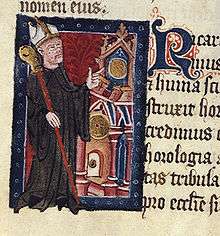
The earliest medieval European clockmakers were Christian monks.[95] Medieval religious institutions required clocks because they regulated daily prayer- and work-schedules strictly, using various types of time-telling and recording devices, such as water clocks, sundials and marked candles, probably in combination.[43][96] When mechanical clocks came into use, they were often wound at least twice a day to ensure accuracy.[97] Monasteries broadcast important times and durations with bells, rung either by hand or by a mechanical device, such as by a falling weight or by rotating beater.
Although the mortuary inscription of Pacificus, archdeacon of Verona, records that he constructed a night clock (horologium nocturnum) as early as 850,[98] his clock has been identified as being an observation tube used to locate stars with an accompanying book of astronomical observations, rather than a mechanical or water clock, an interpretation supported by illustrations from medieval manuscripts.[99][100]
The religious necessities and technical skill of the medieval monks were crucial factors in the development of clocks, as the historian Thomas Woods writes:
The monks also counted skillful clock-makers among them. The first recorded clock was built by the future Pope Sylvester II for the German town of Magdeburg, around the year 996. Much more sophisticated clocks were built by later monks. Peter Lightfoot, a 14th-century monk of Glastonbury, built one of the oldest clocks still in existence, which now sits in excellent condition in London's Science Museum.[101]
The appearance of clocks in writings of the 11th century implies that they were well known in Europe in that period.[102] In the early 14th-century, the Florentine poet Dante Alighieri referred to a clock in his Paradiso;[103] the first known literary reference to a clock that struck the hours.[102] Giovanni da Dondi, Professor of Astronomy at Padua, presented the earliest detailed description of clockwork in his 1364 treatise Il Tractatus Astrarii.[104] This has inspired several modern replicas, including some in London's Science Museum and the Smithsonian Institution.[104] Other notable examples from this period were built in Milan (1335), Strasbourg (1354), Lund (1380), Rouen (1389), and Prague (1462).[104]
Salisbury cathedral clock, dating from about 1386, is one of the oldest working clocks in the world, and may be the oldest. It still has most of its original parts,[105] although its original verge and foliot timekeeping mechanism is lost, having been converted to a pendulum, which was replaced by a replica verge in 1956. It has no dial, as its purpose was to strike a bell at precise times.[105] The wheels and gears are mounted in an open, box-like iron frame, measuring about 1.2 metres (3.9 ft) square. The framework is held together with metal dowels and pegs. Two large stones, hanging from pulleys, supply the power. As the weights fall, ropes unwind from the wooden barrels. One barrel drives the main wheel, which is regulated by the escapement, and the other drives the striking mechanism and the air brake.[105]
Note also Peter Lightfoot's Wells Cathedral clock, constructed c. 1390.[106][107] The dial represents a geocentric view of the universe, with the Sun and Moon revolving around a central fixed Earth. It is unique in having its original medieval face, showing a philosophical model of the pre-Copernican universe.[108] Above the clock is a set of figures, which hit the bells, and a set of jousting knights who revolve around a track every 15 minutes.[108][109] The clock was converted to pendulum-and-anchor escapement in the 17th century, and was installed in London's Science Museum in 1884, where it continues to operate.[109] Similar astronomical clocks, or horologes, survive at Exeter, Ottery St Mary, and Wimborne Minster.
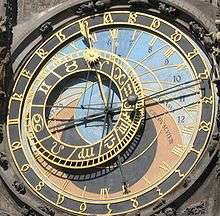
One clock that has not survived is that of the Abbey of St Albans, built by the 14th-century abbot Richard of Wallingford.[110] It may have been destroyed during Henry VIII's Dissolution of the Monasteries, but the abbot's notes on its design have allowed a full-scale reconstruction. As well as keeping time, the astronomical clock could accurately predict lunar eclipses, and may have shown the Sun, Moon (age, phase, and node), stars and planets, as well as a wheel of fortune, and an indicator of the state of the tide at London Bridge.[111] According to Thomas Woods, "a clock that equaled it in technological sophistication did not appear for at least two centuries".[101][112] Giovanni de Dondi was another early mechanical clockmaker whose clock did not survive, but his work has been replicated based on the designs. De Dondi's clock was a seven-faced construction with 107 moving parts, showing the positions of the Sun, Moon, and five planets, as well as religious feast days.[111] Around this period, mechanical clocks were introduced into abbeys and monasteries to mark important events and times, gradually replacing water clocks which had served the same purpose.[113][114]
During the Middle Ages, clocks primarily served religious purposes; the first employed for secular timekeeping emerged around the 15th century. In Dublin, the official measurement of time became a local custom, and by 1466 a public clock stood on top of the Tholsel (the city court and council chamber).[115] It was the first of its kind to be clearly recorded in Ireland, and would only have had an hour hand.[115] The increasing lavishness of castles led to the introduction of turret clocks.[116] A 1435 example survives from Leeds castle; its face is decorated with the images of the Crucifixion of Jesus, Mary and St George.[116]
Clock towers in Western Europe in the Middle Ages were also sometimes striking clocks. The most famous original still standing is possibly St Mark's Clock on the top of St Mark's Clocktower in St Mark's Square in Venice, assembled in 1493 by the clockmaker Gian Carlo Rainieri from Reggio Emilia. In 1497, Simone Campanato moulded the great bell on which every definite time-lapse is beaten by two mechanical bronze statues (h. 2,60 m.) called Due Mori (Two Moors), handling a hammer. Possibly earlier (1490) is the Prague Astronomical Clock by clockmaster Jan Růže (also called Hanuš) – according to another source this device was assembled as early as 1410 by clockmaker Mikuláš of Kadaň and mathematician Jan Šindel. The allegorical parade of animated sculptures rings on the hour every day.
Early clock dials showed hours: the display of minutes and seconds evolved later. A clock with a minutes dial is mentioned in a 1475 manuscript,[117] and clocks indicating minutes and seconds existed in Germany in the 15th century.[118] Timepieces which indicated minutes and seconds were occasionally made from this time on, but this was not common until the increase in accuracy made possible by the pendulum clock and, in watches, by the spiral balance spring. The 16th-century astronomer Tycho Brahe used clocks with minutes and seconds to observe stellar positions.[117]
The Ottoman engineer Taqi al-Din described a weight-driven clock with a verge-and-foliot escapement, a striking train of gears, an alarm, and a representation of the moon's phases in his book The Brightest Stars for the Construction of Mechanical Clocks (Al-Kawākib al-durriyya fī wadh' al-bankāmat al-dawriyya), written around 1556.[119]
Pendulum clock
Innovations to the mechanical clock continued, with miniaturization leading to domestic clocks in the 15th century, and personal watches in the 16th.[104] In the 1580s, the Italian polymath Galileo Galilei investigated the regular swing of the pendulum, and discovered that it could be used to regulate a clock.[43][120] Although Galileo studied the pendulum as early as 1582, he never actually constructed a clock based on that design.[43] The first pendulum clock was designed and built by Dutch scientist Christiaan Huygens, in 1656.[43] Early versions erred by less than one minute per day, and later ones only by 10 seconds, very accurate for their time.[43]
In England, the manufacturing of pendulum clocks was soon taken up.[121] The longcase clock (also known as the grandfather clock) was first created to house the pendulum and works by the English clockmaker William Clement in 1670 or 1671; this became feasible after Clement invented the anchor escapement mechanism[122] in about 1670.[123] Before then, pendulum clocks used the older verge escapement mechanism, which required very wide pendulum swings of about 100°. To avoid the need for a very large case, most clocks using the verge escapement had a short pendulum. The anchor mechanism, however, reduced the pendulum's necessary swing to between 4° to 6°, allowing clockmakers to use longer pendulums with consequently slower beats. These required less power to move, caused less friction and wear, and were more accurate than their shorter predecessors. Most longcase clocks use a pendulum about a metre (39 inches) long to the center of the bob, with each swing taking one second. This requirement for height, along with the need for a long drop space for the weights that power the clock, gave rise to the tall, narrow case.[124]
Clement also introduced the pendulum suspension spring in 1671. The concentric minute hand was added to the clock by Daniel Quare, a London clock-maker, and the Second Hand was introduced.
The Jesuits were another major contributor to the development of pendulum clocks in the 17th and 18th centuries, having had an "unusually keen appreciation of the importance of precision".[125][126] In measuring an accurate one-second pendulum, for example, the Italian astronomer Father Giovanni Battista Riccioli persuaded nine fellow Jesuits "to count nearly 87,000 oscillations in a single day".[126] They served a crucial role in spreading and testing the scientific ideas of the period, and collaborated with contemporary scientists, such as Huygens.[125]
Pocket watch
In 1675, Huygens and Robert Hooke invented the spiral balance, or the hairspring, designed to control the oscillating speed of the balance wheel. This crucial advance finally made accurate pocket watches possible.[120] This resulted in a great advance in accuracy of pocket watches, from perhaps several hours per day to 10 minutes per day, similar to the effect of the pendulum upon mechanical clocks.[15][127] The great English clockmaker, Thomas Tompion, was one of the first to use this mechanism successfully in his pocket watches, and he adopted the minute hand which, after a variety of designs were trialled, eventually stabilised into the modern-day configuration.[121]
The Rev. Edward Barlow invented the rack and snail striking mechanism for striking clocks, which was a great improvement over the previous mechanism. The repeating clock, that chimes the number of hours (or even minutes) was invented by either Quare or Barlow in 1676. George Graham invented the deadbeat escapement for clocks in 1720.
Equation clock
In the late 17th and 18th Centuries, equation clocks were made, which allowed the user to see or calculate apparent solar time, as would be shown by a sundial. Before the invention of the pendulum clock, sundials were the only accurate timepieces. When good clocks became available, they appeared inaccurate to people who were used to trusting sundials. The annual variation of the equation of time made a clock up to about 15 minutes fast or slow, relative to a sundial, depending on the time of year. Equation clocks satisfied the demand for clocks that always agreed with sundials. Several types of equation clock mechanism were devised. which can be seen in surviving examples, mostly in museums.
Chronometer
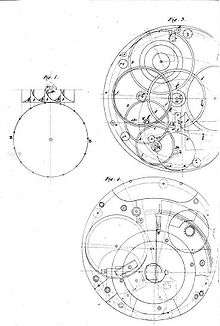
Marine chronometers are clocks used at sea as time standards, to determine longitude by celestial navigation.[129] A major stimulus to improving the accuracy and reliability of clocks was the importance of precise time-keeping for navigation. The position of a ship at sea could be determined with reasonable accuracy if a navigator could refer to a clock that lost or gained less than about 10 seconds per day. The marine chronometer would have to keep the time of a fixed location—usually Greenwich Mean Time—allowing seafarers to determine longitude by comparing the local high noon to the clock.[129][130][131] This clock could not contain a pendulum, which would be virtually useless on a rocking ship.

After the Scilly naval disaster of 1707 where four ships ran aground due to navigational mistakes, the British government offered a large prize of £20,000, equivalent to millions of pounds today, for anyone who could determine longitude accurately. The reward was eventually claimed in 1761 by Yorkshire carpenter John Harrison, who dedicated his life to improving the accuracy of his clocks.
In 1735 Harrison built his first chronometer, which he steadily improved on over the next thirty years before submitting it for examination. The clock had many innovations, including the use of bearings to reduce friction, weighted balances to compensate for the ship's pitch and roll in the sea and the use of two different metals to reduce the problem of expansion from heat.
The chronometer was trialled in 1761 by Harrison's son and by the end of 10 weeks the clock was in error by less than 5 seconds.[132]
Wristwatch
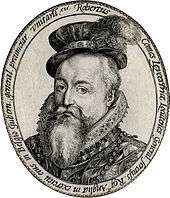
The concept of the wristwatch goes back to the production of the very earliest watches in the 16th century. Elizabeth I of England received a wristwatch from Robert Dudley in 1571, described as an arm watch. From the beginning, wrist watches were almost exclusively worn by women, while men used pocket-watches up until the early 20th century. This was not just a matter of fashion or prejudice; watches of the time were notoriously prone to fouling from exposure to the elements, and could only reliably be kept safe from harm if carried securely in the pocket. When the waistcoat was introduced as a manly fashion at the court of Charles II in the 17th century, the pocket watch was tucked into its pocket. Prince Albert, the consort to Queen Victoria, introduced the 'Albert chain' accessory, designed to secure the pocket watch to the man's outergarment by way of a clip. By the mid nineteenth century, most watchmakers produced a range of wristwatches, often marketed as bracelets, for women.[133]
Wristwatches were first worn by military men towards the end of the nineteenth century, when the importance of synchronizing manoeuvres during war without potentially revealing the plan to the enemy through signalling was increasingly recognized. It was clear that using pocket watches while in the heat of battle or while mounted on a horse was impractical, so officers began to strap the watches to their wrist. The Garstin Company of London patented a 'Watch Wristlet' design in 1893, although they were probably producing similar designs from the 1880s. Clearly, a market for men's wristwatches was coming into being at the time. Officers in the British Army began using wristwatches during colonial military campaigns in the 1880s, such as during the Anglo-Burma War of 1885.[133]
During the Boer War, the importance of coordinating troop movements and synchronizing attacks against the highly mobile Boer insurgents was paramount, and the use of wristwatches subsequently became widespread among the officer class. The company Mappin & Webb began production of their successful 'campaign watch' for soldiers during the campaign at the Sudan in 1898 and ramped up production for the Boer War a few years later.[133]
.jpg)
These early models were essentially standard pocket-watches fitted to a leather strap, but by the early 20th century, manufacturers began producing purpose-built wristwatches. The Swiss company, Dimier Frères & Cie patented a wristwatch design with the now standard wire lugs in 1903. In 1904, Alberto Santos-Dumont, an early aviator, asked his friend, a French watchmaker called Louis Cartier, to design a watch that could be useful during his flights.[134] [135] Hans Wilsdorf moved to London in 1905 and set up his own business with his brother-in-law Alfred Davis, Wilsdorf & Davis, providing quality timepieces at affordable prices – the company later became Rolex.[136] Wilsdorf was an early convert to the wristwatch, and contracted the Swiss firm Aegler to produce a line of wristwatches. His Rolex wristwatch of 1910 became the first such watch to receive certification as a chronometer in Switzerland and it went on to win an award in 1914 from Kew Observatory in Greenwich.[137]
The impact of the First World War dramatically shifted public perceptions on the propriety of the man's wristwatch, and opened up a mass market in the post-war era. The creeping barrage artillery tactic, developed during the War, required precise synchronization between the artillery gunners and the infantry advancing behind the barrage. Service watches produced during the War were specially designed for the rigours of trench warfare, with luminous dials and unbreakable glass. Wristwatches were also found to be needed in the air as much as on the ground: military pilots found them more convenient than pocket watches for the same reasons as Santos-Dumont had. The British War Department began issuing wristwatches to combatants from 1917.[138]
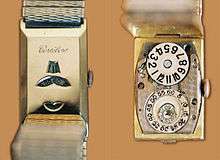
The company H. Williamson Ltd., based in Coventry, was one of the first to capitalize on this opportunity. During the company's 1916 AGM it was noted that "...the public is buying the practical things of life. Nobody can truthfully contend that the watch is a luxury. It is said that one soldier in every four wears a wristlet watch, and the other three mean to get one as soon as they can." By the end of the War, almost all enlisted men wore a wristwatch, and after they were demobilized, the fashion soon caught on – the British Horological Journal wrote in 1917 that "...the wristlet watch was little used by the sterner sex before the war, but now is seen on the wrist of nearly every man in uniform and of many men in civilian attire." Within a decade, sales of wristwatches had outstripped those of pocket watches.[133]
Clockmaking industry
The first professional clockmakers came from the guilds of locksmiths and jewellers. Clockmaking developed from a specialized craft into a mass production industry over many years.[139]
Paris and Blois were the early centers of clockmaking in France. French clockmakers such as Julien Le Roy, clockmaker of Versailles, were leaders in case design and ornamental clocks.[139] Le Roy belonged to the fifth generation of a family of clockmakers, and was described by his contemporaries as "the most skillful clockmaker in France, possibly in Europe". He invented a special repeating mechanism which improved the precision of clocks and watches, a face that could be opened to view the inside clockwork, and made or supervised over 3,500 watches. The competition and scientific rivalry resulting from his discoveries further encouraged researchers to seek new methods of measuring time more accurately.[140]
Between 1794 and 1795, in the aftermath of the French Revolution, the French government briefly mandated decimal clocks, with a day divided into 10 hours of 100 minutes each.[141] The astronomer and mathematician Pierre-Simon Laplace, among other individuals, modified the dial of his pocket watch to decimal time.[141] A clock in the Palais des Tuileries kept decimal time as late as 1801, but the cost of replacing all the nation's clocks prevented decimal clocks from becoming widespread.[142] Because decimalized clocks only helped astronomers rather than ordinary citizens, it was one of the most unpopular changes associated with the metric system, and it was abandoned.[142]
In Germany, Nuremberg and Augsburg were the early clockmaking centers, and the Black Forest came to specialize in wooden cuckoo clocks.[143]

The English became the predominant clockmakers of the 17th and 18th centuries. The main centres of the British industry were in the City of London, the West End of London, Soho where many skilled French Huguenots settled and later in Clerkenwell. The Worshipful Company of Clockmakers was established in 1631 as one of the Livery Companies of the City of London.
Thomas Tompion was the first English clockmaker with an international reputation and many of his pupils went on to become great horologists in their own right, such as George Graham who invented the deadbeat escapement, orrery and mercury pendulum, and his pupil Thomas Mudge who created the first lever escapement. Famous clockmakers of this period included Joseph Windmills, Simon de Charmes who established the De Charmes clockmaker firm and Christopher Pinchbeck who used the Pinchbeck alloy.[144]
Later famous horologists included John Arnold who made the first practical and accurate modern watch by refining Harrison's chronometer, Thomas Earnshaw who was the first to make these available to the public, Daniel Quare, who invented a repeating watch movement, a portable barometer and introduced the concentric minute hand.
Quality control and standards were imposed on clockmakers by the Worshipful Company of Clockmakers, a guild which licensed clockmakers for doing business. By the rise of consumerism in the late 18th century, clocks, especially pocket watches, became regarded as fashion accessories and were made in increasingly decorative styles. By 1796, the industry reached a high point with almost 200,000 clocks being produced annually in London, however by the mid-19th century the industry had gone into steep decline from Swiss competition.[145]
Switzerland established itself as a clockmaking center following the influx of Huguenot craftsmen, and in the 19th century, the Swiss industry "gained worldwide supremacy in high-quality machine-made watches". The leading firm of the day was Patek Philippe, founded by Antoni Patek of Warsaw and Adrien Philippe of Bern.[139]
Electric clock
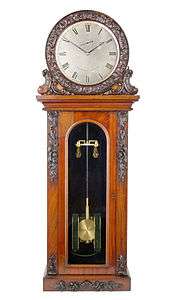
In 1814, Sir Francis Ronalds (1788) of London invented the forerunner of an electric clock, the electrostatic clock. His prototype was powered with a dry pile battery. It proved unreliable in timekeeping, however, because of a strong dependence on a stable room temperature and 'weather conditions'.
Alexander Bain, a Scottish clock and instrument maker, was the first to invent and patent the electric clock in 1840. On January 11, 1841, Alexander Bain along with John Barwise, a chronometer maker, took out another important patent describing a clock in which an electromagnetic pendulum and an electric current is employed to keep the clock going instead of springs or weights. Later patents expanded on his original ideas.
Quartz clock

The piezoelectric properties of crystalline quartz were discovered by Jacques and Pierre Curie in 1880.[43][146] The first quartz crystal oscillator was built by Walter G. Cady in 1921, and in 1927 the first quartz clock was built by Warren Marrison and J. W. Horton at Bell Telephone Laboratories in Canada.[147][148] The following decades saw the development of quartz clocks as precision time measurement devices in laboratory settings—the bulky and delicate counting electronics, built with vacuum tubes, limited their practical use elsewhere. In 1932, a quartz clock able to measure small weekly variations in the rotation rate of the Earth was developed.[148] The National Bureau of Standards (now NIST) based the time standard of the United States on quartz clocks from late 1929 until the 1960s, when it changed to atomic clocks.[149] In 1969, Seiko produced the world's first quartz wristwatch, the Astron.[150] Their inherent accuracy and low cost of production has resulted in the subsequent proliferation of quartz clocks and watches.[43]
Atomic clock
Atomic clocks are the most accurate timekeeping devices in practical use today. Accurate to within a few seconds over many thousands of years, they are used to calibrate other clocks and timekeeping instruments.[151]
The idea of using atomic transitions to measure time was first suggested by Lord Kelvin in 1879,[152] although it was only in the 1930s with the development of Magnetic resonance that there was a practical method for doing this.[153] A prototype ammonia maser device was built in 1949 at the U.S. National Bureau of Standards (NBS, now NIST). Although it was less accurate than existing quartz clocks, it served to demonstrate the concept.[154] [155][156]
The first accurate atomic clock, a caesium standard based on a certain transition of the caesium-133 atom, was built by Louis Essen in 1955 at the National Physical Laboratory in the UK.[157] Calibration of the caesium standard atomic clock was carried out by the use of the astronomical time scale ephemeris time (ET).[158]
The International System of Units standardized its unit of time, the second, on the properties of cesium in 1967.[156] SI defines the second as 9,192,631,770 cycles of the radiation which corresponds to the transition between two electron spin energy levels of the ground state of the 133Cs atom.[159] The cesium atomic clock, maintained by the National Institute of Standards and Technology, is accurate to 30 billionths of a second per year.[156] Atomic clocks have employed other elements, such as hydrogen and rubidium vapor, offering greater stability—in the case of hydrogen clocks—and smaller size, lower power consumption, and thus lower cost (in the case of rubidium clocks).[156]
See also
- book of hours (horologion or horologium, from which the modern French word horloge for clock stems)
- canonical hours
- Clock synchronization
- Global Positioning System
- horology
- hour, hora
- UTC
Footnotes
- ↑ David Landes: "Revolution in Time: Clocks and the Making of the Modern World", rev. and enlarged edition, Harvard University Press, Cambridge 2000, ISBN 0-674-00282-2, p.18f.
- 1 2 3 Lewis 2000, pp. 343–369 (356f.)
- 1 2 Needham, Joseph (1986). "Science and Civilization in China". Physics and Physical Technology, Part 2: Mechanical Engineering. Taipei: Caves Books, Ltd. 4: 411.
- 1 2 3 4 Hassan, Ahmad Y, Transfer Of Islamic Technology To The West, Part II: Transmission Of Islamic Engineering, History of Science and Technology in Islam
- 1 2 Chobotov, p. 1
- 1 2 3 4 5 Bruton, Eric (1979). The History of Clocks and Watches. New York: Crescent Books. ISBN 0-517-37744-6.
- ↑ Barnett, p. 102
- ↑ Aveni, p. 136
- ↑ "Ancient Calendars". National Institute of Standards and Technology. Archived from the original on April 9, 2008. Retrieved 30 April 2008.
- ↑ Richards, p. 55
- 1 2 One of world's oldest sundials dug up in Kings' Valley, Upper Egypt
- ↑ Major, p. 9
- ↑ "Sundial". Encyclopædia Britannica. Retrieved 4 April 2008.
- ↑ Bruton, Eric (1979). The History of Clocks and Watches (1982 ed.). New York: Crescent Books. ISBN 0-517-37744-6.
- 1 2 3 4 5 6 7 "Earliest Clocks". A Walk Through Time. NIST Physics Laboratory. Archived from the original on March 15, 2008. Retrieved 2 April 2008.
- ↑ Barnett, p. 18
- ↑ "How does an hourglass measure time?". Library of Congress. Retrieved 31 March 2008.
- ↑ Berlev, p. 118
- ↑ Philbin, p. 128
- ↑ Cotterell, pp. 59–61
- ↑ Whitrow, p. 28
- ↑ Levy, Joel (2002). Really Useful: The Origin of Everyday Things. Firefly Books. p. 63. ISBN 1-55297-622-X. Retrieved 20 June 2008.
- ↑ O'Connor, J. J.; Robertson, E. F. "Plato biography". School of Mathematics and Statistics, University of St. Andrews. Retrieved 29 November 2007.
- 1 2 Hellemans, Alexander; Bunch, Bryan H. (2004). The History of Science and Technology: A Browser's Guide to the Great Discoveries, Inventions, and the People Who Made Them, From the Dawn of Time to Today. Boston: Houghton Mifflin. p. 65. ISBN 0-618-22123-9.
- ↑ Barnett, p. 28
- ↑ Humphrey, John William (1998). Greek and Roman Technology: A Sourcebook. Routledge. pp. 518–519. ISBN 0-415-06136-9. Retrieved 11 April 2008.
- ↑ Apuleius, Lucius (1951). The Transformations of Lucius, Otherwise Known as The Golden Ass. Translated by Robert Graves. New York, New York: Farrar, Straus & Giroux. p. 54. ISBN 0-374-50532-2.
- ↑ Rees, Abraham (1970). Rees's clocks, watches, and chronometers (1819–20); a selection from the Cyclopaedia, or Universal dictionary of arts, sciences, and literature. Rutland, Vt: C. E. Tuttle Co. ISBN 0-8048-0901-1.
- ↑ Aveni, Anthony F. (2000). Empires of Time: Calendars, Clocks, and Cultures. Tauris Parke Paperbacks. p. 92. ISBN 1-86064-602-6. Retrieved 22 June 2008.
- ↑ Collier, James Lincoln (2003). Clocks. Tarrytown, NY: Benchmark Books. p. 25. ISBN 0-7614-1538-6.
- ↑ O'Connor, J. J.; Robertson, E. F. "Theodosius biography". School of Mathematics and Statistics, University of St. Andrews. Retrieved 1 April 2008.
- ↑ "Marcus Vitruvius Pollio: de Architectura, Book IX". The Latin text is that of the Teubner edition of 1899 by Valentin Rose, transcribed by Bill Thayer. 7 July 2007. Retrieved 7 September 2007.
- ↑ Buchner, Edmund (1976). "Solarium Augusti und Ara Pacis". Römische Mitteilungen (in German). Berlin. 83 (2): 319–375.
- ↑ National Maritime Museum; Lippincott, Kristen; Eco, Umberto; Gombrich, E. H. (1999). The Story of Time. London: Merrell Holberton in association with National Maritime Museum. ISBN 1-85894-072-9.
- ↑ Barnett, p. 21
- 1 2 3 Conference of Qanat in Iran – water clock in Persia 1383, in Persian
- 1 2 سايهي شهرداري نجفآباد بر كهنترين «ساعت آبي» شهر Amordad News (in Persian)
- 1 2 Needham, Joseph (1986). "Science and Civilization in China". Physics and Physical Technology, Part 2: Mechanical Engineering. Taipei: Caves Books, Ltd. 4: 479–480.
- ↑ "Clock Etymology". Online Etymology Dictionary. Retrieved 27 April 2008.
- ↑ "Merriam-Webster Online: Clock". Webster's Dictionary. Retrieved 20 June 2008.
- ↑ executive editor, Joseph P. Pickett (1992). The American Heritage Dictionary of the English Language (Fourth ed.). Houghton Mifflin. ISBN 0-395-82517-2. Archived from the original on December 5, 2008. Retrieved 4 December 2007.
- ↑ "Mechanical Timekeeping". St. Edmundsbury Borough Council. Archived from the original on July 4, 2008. Retrieved 10 December 2007.
- 1 2 3 4 5 6 7 8 "A Revolution in Timekeeping". NIST. Archived from the original on April 9, 2008. Retrieved 30 April 2008.
- ↑ Flamer, Keith (2006). "History of Time". International Watch Magazine. Archived from the original on July 16, 2011. Retrieved 8 April 2008.
- ↑ "Clockworks: Candle clock". Encyclopædia Britannica. Retrieved 16 March 2008.
- ↑ Ancient Discoveries, Episode 12: Machines of the East. History Channel. Retrieved 7 September 2008.
- 1 2 Routledge Hill, Donald, "Mechanical Engineering in the Medieval Near East", Scientific American, May 1991, pp. 64–9 (cf. Donald Routledge Hill, Mechanical Engineering) Archived March 5, 2008, at the Wayback Machine.
- ↑ Richards, p. 52
- ↑ Pagani, Catherine (2001). Eastern Magnificence and European Ingenuity: Clocks of Late Imperial China. University of Michigan Press. p. 209. ISBN 0-472-11208-2.
- 1 2 Schafer, Edward (1963). The Golden Peaches of Samarkand: A Study of T'ang Exotics. University of California Press. pp. 160–161. ISBN 0-520-05462-8.
- ↑ Chang, Edward; Lu, Yung-Hsiang (December 1996). "Visualizing Video Streams using Sand Glass Metaphor". Stanford University. Retrieved 20 June 2008.
- 1 2 3 Fraser, Julius (1990). Of Time, Passion, and Knowledge: Reflections on the Strategy of Existence. Princeton University Press. pp. 55–56. ISBN 0-691-02437-5.
- 1 2 "Time Activity: Incense Clock". Chicago: Museum of Science and Industry. Archived from the original on July 4, 2008. Retrieved 29 April 2008.
- ↑ Levy, p. 18
- ↑ "Asian Gallery – Incense Clock". National Watch and Clock Museum. Retrieved 28 April 2008.
- ↑ Richards, p. 130
- ↑ Rossotti, Hazel (2002). Fire: Servant, Scourge, and Enigma. Dover Publications. p. 157. ISBN 0-486-42261-5.
- ↑ Bedini, Silvio (1994). The Trail of Time: Shih-chien Ti Tsu-chi: Time Measurement with Incense in East Asia. Cambridge University Press. p. 183. ISBN 0-521-37482-0.
- 1 2 Bedini, pp. 103–104
- ↑ Fraser, p. 52
- 1 2 Bedini, p. 187
- ↑ Bedini, Silvio A. (1963). "The Scent of Time. A Study of the Use of Fire and Incense for Time Measurement in Oriental Countries". Transactions of the American Philosophical Society. Philadelphia, Pennsylvania: American Philosophical Society. 53 (5): 1–51. doi:10.2307/1005923. JSTOR 1005923.
- ↑ Bedini, p. 105
- ↑ Fraser, J. A. (1987). Time, The Familiar Stranger. Amherst: University of Massachusetts Press. p. 52. ISBN 0-87023-576-1.
- ↑ Fraser, p. 56
- ↑ Bedini, pp. 104–106
- ↑ "History of the sundial". National Maritime Museum. Retrieved 2 July 2008.
- ↑ Jones, Lawrence (December 2005). "The Sundial And Geometry". North American Sundial Society. 12 (4).
- ↑ Mayall, Margaret W.; Mayall, R. Newton (2002). Sundials: Their Construction and Use. New York: Dover Publications. p. 17. ISBN 0-486-41146-X.
- ↑ O'Connor, J. J.; Robertson, E. F. "Fine biography". School of Mathematics and Statistics, University of St. Andrews. Retrieved 31 March 2008.
- ↑ Aked, Charles K.; Severino, Nicola (1997). "Bibliografia della Gnomonica" (PDF) (in Latin). British Sundial Society. p. 119. Retrieved 21 June 2008.
- ↑ American Society of Mechanical Engineers (2002). Proceedings of the 2002 ASME Design Engineering Technical Conferences. American Society of Mechanical Engineers. ISBN 0-7918-3624-X.
- ↑ Schafer, Edward H. (1967). Great Ages of Man: Ancient China. New York: Time-Life Books. p. 128. ISBN 0-900658-10-X.
- 1 2 "The mechanical clock" (PDF). UNESCO Courier. October 1988. pp. 26–27. Retrieved 16 April 2008.
- ↑ Tomczak, Matthias. "The Water Clock of 1088". Flinders University (es.flinders.edu.au). Retrieved 29 April 2008.
- ↑ Needham, Volume 4, Part 2, p. 165
- ↑ Donald Routledge Hill (1991). "Arabic Mechanical Engineering: Survey of the Historical Sources". Arabic Sciences and Philosophy: A Historical Journal. Cambridge University Press. 1 (2): 167–186 [174]. doi:10.1017/S0957423900001478.
- ↑ Donald Routledge Hill (1991). "Arabic Mechanical Engineering: Survey of the Historical Sources". Arabic Sciences and Philosophy: A Historical Journal. Cambridge University Press. 1 (2): 167–186 [180]. doi:10.1017/S0957423900001478.
- 1 2 3 Donald Routledge Hill (1996). A history of engineering in classical and medieval times. Routledge. pp. 203, 223, 242. ISBN 0-415-15291-7.
- ↑ Donald Routledge Hill (1991). "Arabic Mechanical Engineering: Survey of the Historical sources". Arabic Sciences and Philosophy: A Historical Journal. Cambridge University Press. 1 (2): 167–186 [173]. doi:10.1017/S0957423900001478.
- 1 2 Mario Taddei. "The Book of Secrets is coming to the world after a thousand years: Automata existed already in the eleventh century!" (PDF). Leonardo3. Retrieved 31 March 2010.
- ↑ Juan Vernet; Julio Samso. "Development of Arabic Science in Andalusia". In Roshdi Rashed; Régis Morelon. Encyclopedia of the History of Arabic Science. 1. Routledge. pp. 243–275 [260–1]. ISBN 0-415-12410-7.
- 1 2 Donald Routledge Hill (1996), "Engineering", p. 794, in Rashed & Morelon (1996) pp. 751–95
- ↑ Silvio A. Bedini (1962), "The Compartmented Cylindrical Clepsydra", Technology and Culture, Vol. 3, No. 2, pp. 115–141 (116–118)
- ↑ Mills, A. A. (1988). "The mercury clock of the Libros del Saber". Annals of Science. 45 (4): 329–344 [332]. doi:10.1080/00033798800200271.
- ↑ Ajram, K. (1992). "Appendix B". Miracle of Islamic Science. Knowledge House Publishers. ISBN 0-911119-43-4.
- ↑ Hill, Donald R. (May 1991). "Mechanical Engineering in the Medieval Near East". Scientific American: 64–69.
- ↑ King, David A. (1983). "The Astronomy of the Mamluks". Isis. 74 (4): 531–555 [545–546]. doi:10.1086/353360.
- ↑ Howard R. Turner (1997), Science in Medieval Islam: An Illustrated Introduction, p. 184. University of Texas Press, ISBN 0-292-78149-0.
- ↑ Ancient Discoveries, Episode 11: Ancient Robots. History Channel. Retrieved 6 September 2008.
- ↑ Frugoni p. 83
- ↑ Macey, Samuel L. (1994). Encyclopedia of Time. New York: Garland Pub. p. 209. ISBN 0-8153-0615-6.
- ↑ Blaut, James Morris (2000). Eight Eurocentric Historians. Guildford Press. p. 186. ISBN 1-57230-591-6.
- ↑ Bergreen, Laurence (2003). Over the Edge of the World: Magellan's Terrifying Circumnavigation of the Globe. New York: Morrow. p. 53. ISBN 0-06-621173-5.
- ↑ Kleinschmidt, Harald (2000). Understanding the Middle Ages. Boydell & Brewer. p. 26. ISBN 0-85115-770-X.
- ↑ Payson Usher, Abbot (1988). A History of Mechanical Inventions. Courier Dover Publications. ISBN 0-486-25593-X.
- ↑ Usher, p. 194
- ↑ "A history of mechanical inventions", Abbott Payson Usher(1929), p.192 "
- ↑ Gerhard Dohrn-van Rossum, History of the Hour: Clocks and Modern Temporal Orders, (University of Chicago Press, 1996), p 54.
- ↑ St. Gallen, Stiftsbibliothek, Cod. Sang. 18: Composite manuscript, astronomical clock of Pacificus of Verona
- 1 2 Woods, p. 36
- 1 2 Reid, p. 4
- ↑ "Then, as a horologe that calleth us / What time the Bride of God is rising up". "Paradiso – Canto X – Divine Comedy – Dante Alighieri – La Divina Commedia". About.com. Retrieved 11 April 2008.
- 1 2 3 4 Davies, Norman; p. 434
- 1 2 3 "Oldest Working Clock, Frequently Asked Questions, Salisbury Cathedral". Retrieved 4 April 2008.
- ↑ "Wells Cathedral Clock – BBC". British Broadcasting Corporation. Retrieved 22 June 2008.
- ↑ "Catholic Encyclopedia: Glastonbury Abbey". Kevin Knight. Retrieved 10 December 2007.
- 1 2 "Wells Cathedral History". WellsCathedral.org.uk. Retrieved 21 June 2008.
- 1 2 "Wells Cathedral clock, c.1392". Science Museum (London). Retrieved 11 February 2008.
- ↑ Gransden, Antonia (1996). Historic Writing in England. Routledge. p. 122. ISBN 0-415-15125-2.
- 1 2 Burnett-Stuart, George. "De Dondi's Astrarium". Almagest. Computastat Group Ltd. Retrieved 21 April 2008.
- ↑ Macey, p. 130
- ↑ North, John David (2005). God's Clockmaker: Richard of Wallingford and the Invention of Time. Hambledon & London. p. xv. ISBN 1-85285-451-0.
- ↑ Watson, E. (1979). "The St. Albans Clock of Richard of Wallingford". Antiquarian Horology. Antiquarian Horological Society. 11 (6): 372–384.
- 1 2 Clarke, p. 60
- 1 2 Bottomley, p. 34
- 1 2 p. 529, "Time and timekeeping instruments", History of astronomy: an encyclopedia, John Lankford, Taylor & Francis, 1997, ISBN 0-8153-0322-X.
- ↑ p. 209, A history of mechanical inventions, Abbott Payson Usher, Courier Dover Publications, 1988, ISBN 0-486-25593-X.
- ↑ Ahmad Y al-Hassan & Donald R. Hill (1986), "Islamic Technology", Cambridge, ISBN 0-521-42239-6, p. 59
- 1 2 Davies, Eryl (1995). Pockets: Inventions. London: Dorling Kindersley. ISBN 0-7513-5184-9.
- 1 2 "HISTORY OF CLOCKS".
- ↑ "The History of Mechanical Pendulum Clocks and Quartz Clocks". about.com. 2012. Retrieved 16 June 2012.
- ↑ Derry, T. K. (1993). A Short History of Technology: From the Earliest Times to A.D. 1900. Courier Dover Publications. p. 293. ISBN 0-486-27472-1.
- ↑ Brain, Marshall. "How Pendulum Clocks Work". HowStuffWorks. Retrieved 10 December 2007.
- 1 2 Woods, pp. 100–101
- 1 2 Woods, p. 103
- ↑ Milham, Willis I. (1945). Time and Timekeepers. New York: MacMillan. p. 226. ISBN 0-7808-0008-7.
- ↑ The principles of Mr Harrison's time-keeper
- 1 2 "Marine Chronometers Gallery". National Association of Watch and Clock Collectors. Retrieved 20 May 2008.
- ↑ Marchildon, Jérôme. "Science News – The Marine Chronometer". Manitoba Museum. Archived from the original on September 19, 2006. Retrieved 20 May 2008.
- ↑ "Chronometers, precision watches, and timekeepers". Greenwich: National Maritime Museum. Retrieved 20 May 2008.
- ↑ Gould, Rupert T. (1923). The Marine Chronometer. Its History and Development. London: J. D. Potter. p. 66. ISBN 0-907462-05-7.
- 1 2 3 4 "THe Evolution of the Wristwatch".
- ↑ Prochnow, Dave (2006). Lego Mindstorms NXT Hacker's Guide. McGraw-Hill. ISBN 0-07-148147-8.
- ↑ Silva de Mattos, Bento. "Alberto Santos-Dumont". American Institute of Aeronautics and Astronautics. Retrieved 21 June 2008.
- ↑ Rolex Jubilee Vade Mecum published by the Rolex Watch Company in 1946.
- ↑ John E. Brozek. "The History and Evolution of the Wristwatch.". International Watch Magazine.
- ↑ Hoffman, Paul (2004). Wings of Madness: Alberto Santos-Dumont and the Invention of Flight. Hyperion Press. ISBN 0-7868-8571-8.
- 1 2 3 Davies, Norman; p. 435
- ↑ "Julien Le Roy". Getty Center. Retrieved 5 April 2008.
- 1 2 Alder, pp. 149–150
- 1 2 Alder, pp. 150–162
- ↑ Shull, Thelma (1963). Victorian Antiques. C. E. Tuttle Co. p. 65.
- ↑ "CLOCK AND WATCH-MAKING". British History Online.
- ↑ "England: Where watchmaking all began".
- ↑ "Pierre Curie". American Institute of Physics. Retrieved 8 April 2008.
- ↑ Marrison, W. A.; Horton, J. W. (February 1928). "Precision determination of frequency". I.R.E. Proc. 16 (2): 137–154. doi:10.1109/JRPROC.1928.221372.
- 1 2 Marrison, vol. 27 pp. 510–588
- ↑ Sullivan, D.B. (2001). "Time and frequency measurement at NIST: The first 100 years" (PDF). Time and Frequency Division, National Institute of Standards and Technology. p. 5.
- ↑ "Electronic Quartz Wristwatch, 1969". IEEE History Center. Retrieved 11 July 2015.
- ↑ Dick, Stephen (2002). Sky and Ocean Joined: The U.S. Naval Observatory, 1830–2000. Cambridge University Press. p. 484. ISBN 0-521-81599-1.
- ↑ Sir William Thomson (Lord Kelvin) and Peter Guthrie Tait, Treatise on Natural Philosophy, 2nd ed. (Cambridge, England: Cambridge University Press, 1879), vol. 1, part 1, page 227.
- ↑ M.A. Lombardi; T.P. Heavner; S.R. Jefferts (2007). "NIST Primary Frequency Standards and the Realization of the SI Second" (PDF). Journal of Measurement Science. 2 (4): 74.
- ↑ Sullivan, D.B. (2001). Time and frequency measurement at NIST: The first 100 years (PDF). 2001 IEEE International Frequency Control Symposium. NIST. pp. 4–17.
- ↑ "Time and Frequency Division". National Institute of Standards and Technology. Retrieved 1 April 2008.
- 1 2 3 4 "The "Atomic Age" of Time Standards". National Institute of Standards and Technology. Archived from the original on April 12, 2008. Retrieved 2 May 2008.
- ↑ Essen, L.; Parry, J. V. L. (1955). "An Atomic Standard of Frequency and Time Interval: A Cæsium Resonator". Nature. 176 (4476): 280. Bibcode:1955Natur.176..280E. doi:10.1038/176280a0.
- ↑ W. Markowitz; R.G. Hall; L. Essen; J.V.L. Parry (1958). "Frequency of cesium in terms of ephemeris time". Physical Review Letters. 1: 105–107. Bibcode:1958PhRvL...1..105M. doi:10.1103/PhysRevLett.1.105.
- ↑ "What is a Cesium Atomic Clock?". National Research Council Canada. Retrieved 4 March 2015.
References
- Alder, Ken (2002). The Measure of All Things: The Seven-Year Odyssey and Hidden Error that Transformed the World. London: Little, Brown. ISBN 0-7432-1676-8. OCLC 53324804.
- Aveni, Anthony (2001). Skywatchers: A Revised and Updated Version of Skywatchers of Ancient Mexico. Austin, TX: University of Texas Press. ISBN 0-292-70502-6. OCLC 45195586.
- Barnett, Jo Ellen (1998). Time's Pendulum: From Sundials to Atomic Clocks, the Fascinating History of Timekeeping and How Our Discoveries Changed the World (1st ed.). San Diego, CA: Harcourt Trade Publishers. ISBN 0-15-600649-9. OCLC 40255897.
- R.M.Ghias Abadi (2004) Achaemenid Inscriptions, 2nd edition, publisher Shiraz Navid ISBN 964-358-015-6
- Berlev, Oleg (1997). "Bureaucrats". In Donadoni, Sergio. The Egyptians. Trans. Bianchi, Robert et al. Chicago, IL: The University of Chicago Press. ISBN 0-226-15555-2. OCLC 35808323.
- Bottomley, Frank (1983). The Castle Explorer's Guide. New York, NY: Crown Publishers. ISBN 0-517-42172-0. OCLC 9762252.
- Clarke, Howard B.; Dent, Sarah; Johnson, Ruth (2002). Dublinia: The Story of Medieval Dublin. Dublin, Ireland: O'Brien. ISBN 0-86278-785-8. OCLC 50528116.
- Chobotov, Vladimir (2002). Orbital Mechanics (3rd ed.). Reston, VA: AIAA. ISBN 1-56347-537-5. OCLC 49923275. Retrieved 20 June 2008.
- Cotterell, Brian; Kamminga, Johan (1990). Mechanics of Pre-Industrial Technology: An Introduction to the Mechanics of Ancient and Traditional Material Culture. Cambridge: Cambridge University Press. ISBN 0-521-42871-8. OCLC 18520966.
- Davies, Norman (1996). Europe: A History. Oxford: Oxford University Press. ISBN 0-19-820171-0. OCLC 35593922.
- Frugoni, Chiara (1988). Pietro et Ambrogio Lorenzetti. New York, NY: Scala Books. ISBN 0-935748-80-6. OCLC 18827370.
- Lewis, Michael (2000). "Theoretical Hydraulics, Automata, and Water Clocks". In Wikander, Örjan. Handbook of Ancient Water Technology. Technology and Change in History. 2. Leiden: Brill. pp. 343–369 (356f.). ISBN 90-04-11123-9.
- Major, Fouad G. (1998). The Quantum Beat: The Physical Principles of Atomic Clocks. New York, NY: Springer. ISBN 0-387-98301-5. OCLC 37315254. Retrieved 22 June 2008.
- Marrison, Warren A. (1948). "The Evolution of the Quartz Crystal Clock". Bell System Technical Journal. New York, NY: AT&T. 27: 510–88. doi:10.1002/j.1538-7305.1948.tb01343.x. OCLC 10999639.
- Philbin, Tom (2005). The 100 Greatest Inventions of All Time: A Ranking Past to Present. New York, NY: Citadel Press. ISBN 0-8065-2404-9. OCLC 57166331. Retrieved 20 June 2008.
- Reid, Thomas (1832). Treatise on Clock and Watch Making: Theoretical and Practical. Carey and Lea. OCLC 17454059.
- Richards, E. G. (1998). Mapping Time: The Calendar and its History. Oxford: Oxford University Press. ISBN 0-19-850413-6. OCLC 185547970.
- Whitrow, Gerald J. (1989). Time in History: Views of Time from Prehistory to the Present Day (1st ed.). Oxford: Oxford University Press. ISBN 0-19-285211-6. OCLC 21182984.
- Woods, Thomas (2005). How the Catholic Church Built Western Civilization. Washington D.C., United States: Regnery Publ. ISBN 0-89526-038-7. OCLC 58720707.
Further reading
- Andrews, William J. H. (1996). The Quest for Longitude. Cambridge, Massachusetts: Harvard University Press. ISBN 978-0-9644329-0-1. OCLC 59617314.
- Audoin, Claude; Guinot, Bernard (2001). The Measurement of Time: Time, Frequency, and the Atomic Clock. Cambridge: Cambridge University Press. ISBN 0-521-00397-0.
- Bartky, Ian R. (January 1989). "The Adoption of Standard Time". Technology and Culture. 30 (1): 25–56. doi:10.2307/3105430. JSTOR 3105430.
- Breasted, James H., "The Beginnings of Time Measurement and the Origins of Our Calendar", in Time and its Mysteries, a series of lectures presented by the James Arthur Foundation, New York University, New York: New York University Press, 1936, pp. 59–96.
- Cowan, Harrison J. (1958). Time and Its Measurements. Cleveland: World Publishing Company.
- Dohrn-Van Rossum, Gerhard (1996). History of the Hour: Clocks and Modern Temporal Orders. Chicago: University of Chicago Press. ISBN 0-226-15510-2.
- Frye, Richard N. (1974). "Persepolis Again". Journal of Near Eastern Studies. 33 (4): 383–386. doi:10.1086/372376.
- Garver, Thomas H. (Fall 1992). "Keeping Time". American Heritage of Invention & Technology. 8 (2): 8–17.
- Goudsmit, Samuel A.; Claiborne, Robert; Millikan, Robert A. (1996). Time. New York: Time Inc.
- Hawkins, Gerald S. (1965). Stonehenge Decoded. Garden City, N.Y.: Doubleday. ISBN 978-0-385-04127-0.
- Hellwig, Helmut; Evenson, Kenneth M.; Wineland, David J. (December 1978). "Time, Frequency and Physical Measurement". Physics Today. 23 (12): 23–30. doi:10.1063/1.2994867.
- Hood, Peter (1955). How Time Is Measured. London: Oxford University Press. ISBN 0-19-836615-9.
- Howse, Derek (1980). Greenwich Time and the Discovery of the Longitude. Philip Wilson Publishers, Ltd. ISBN 978-0-19-215948-9.
- Humphrey, Henry; O'Meara-Humphrey, Deirdre (1980). When is Now?: Experiments with Time and Timekeeping Devices. Doubleday Publishing. ISBN 0-385-13215-8.
- Itano, Wayne M.; Ramsey, Norman F. (July 1993). "Accurate Measurement of Time". Scientific American. 269 (1): 56–65. Bibcode:1993SciAm.269...56I. doi:10.1038/scientificamerican0793-56.
- Jespersen, James; Hanson, D. Wayne (July 1991). "Special Issue on Time and Frequency". Proceedings of the IEEE. 79 (7). Archived from the original on January 22, 2016.
- Jespersen, James; Fitz-Randolph, Jane (2000). From Sundials to Atomic Clocks: Understanding Time and Frequency 2nd (revised) edition. Mineola, New York: Dover Publications. ISBN 0-486-40913-9.
- Jones, Tony (2000). Splitting the Second: The Story of Atomic Timekeeping. Bristol, UK: Institute of Physics Publishing. ISBN 978-0-7503-0640-9.
- Landes, Davis S (2000). A Revolution in Time: Clocks and the Making of the Modern World. Cambridge, Massachusetts: Harvard University Press. ISBN 978-0-674-76800-0.
- Lombardi, Michael A., NIST Time and Frequency Services, NIST Special Publication 432*, revised 2002.
- Mayr, Otto (October 1970). "The Origins of Feedback Control". Scientific American. 223 (10): 110–118. doi:10.1038/scientificamerican1070-110.
- Merriam, John C., "Time and Change in History", Time and Its Mysteries, (see Breasted above), pp. 23–38.
- Millikan, Robert A., "Time", Time and Its Mysteries, (see Breasted above) pp. 3–22.
- Morris, Richard (1985). Time's Arrows: Scientific Attitudes Toward Time. New York: Simon and Schuster. ISBN 978-0-671-61766-0.
- Needham, Joseph; Ling, Wang; deSolla Price, Derek J. (1986). Heavenly Clockwork: The Great Astronomical Clocks of Medieval China. Cambridge: Cambridge University Press. ISBN 978-0-521-32276-8.
- Parker, Richard Anthony (1950). The Calendars of Ancient Egypt. University of Chicago. OCLC 2077978.
- Priestley, John Boynton (1964). Man and Time. Garden City, New York: Doubleday.
- Seidelmann, P. Kenneth, ed., Explanatory Supplement to the Astronomical Almanac, Sausalito, Calif.: University Science Books, 1992.
- Shallies, Michael (1983). On Time: An Investigation into Scientific Knowledge and Human Experience. New York: Schocken Books. ISBN 978-0-8052-3853-2.
- Snyder, Wilbert F. and Charles A. Bragaw, "In the Domains of Time and Frequency" (Chapter 8), Achievement in Radio, NIST Special Publication 555*, 1986.
- Sobel, Dava (2005). Longitude. London, England: HarperPerennial. ISBN 978-0-00-721422-8. OCLC 60795122.
- Thompson, David, The History of Watches, New York: Abbeville Press, 2008.
- Waugh, Alexander (1998). Time: Its Origin, Its Enigma, Its History. Carroll & Graf Publishing. ISBN 0-7867-0767-4.
External links
- www.germanclocks.org – for a comprehensive timeline of horology
- Measuring time in ancient Egypt
- A basic Overview
- Relativity Science Calculator – Philosophic Question: are clocks and time separable?
